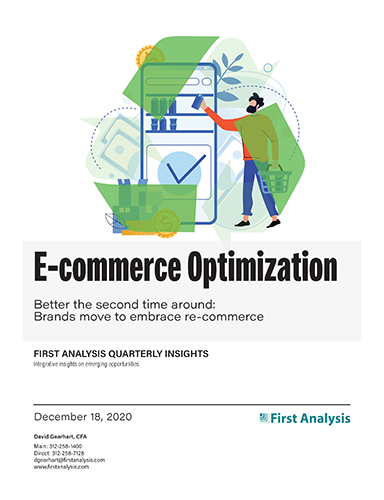Quarterly insights: E-commerce optimization
Better the second time around: Brands move to embrace re-commerce

Re-commerce, short for resale commerce, is a smaller market than the market for new goods but still sizeable at nearly $100 billion in the United States annually and growing quickly. Despite a backdrop of general economic prosperity, more people now view it as acceptable to buy used instead of new.
Brands have been slower to adopt re-commerce than e-commerce marketplaces, other online retailers and traditional retailers. We think this will change within the next few years as brands recognize many compelling benefits of re-commerce.
As brands undertake re-commerce initiatives, we believe most will elect to outsource the underlying technology given the technical capabilities required to build a proprietary capability are often outside their core competencies and outsourcing is generally more cost effective.
We expect technology vendors in several areas to see strong demand from brands seeking to outsource all or part of their re-commerce efforts. We highlight several key technology areas likely to see the most interest and profile some innovative providers of these re-commerce technologies.
TABLE OF CONTENTS
Includes discussion of AMZN, EBAY, WMT, ZAL and eight private companies
- Re-commerce market substantial and growing fast
- Common re-commerce models
- Retailers taking notice, some already entered re-commerce
- Brands lag, but time for them to get involved
- Multi-year tailwind for technology vendors enabling re-commerce
- The second time around
- First Analysis E-commerce Optimization Index hits new peak
- E-commerce optimization M&A pace sustains its recovery
- E-commerce optimization private placements slow in Q4
Re-commerce market substantial and growing fast
Re-commerce, short for resale commerce, means selling used products, returned items, and excess inventory through physical and digital channels; some use the term to include rentals. Virtually any item in good condition with some remaining utility can be resold, including apparel and accessories, housewares, video games and other electronics, and collectibles.
The re-commerce market is smaller than the market for new goods but still sizeable at nearly $100 billion in the United States annually. The apparel and accessories re-commerce category alone is expected to reach $32 billion in 2020 and to double by 2025. Much of the resale volume and revenue flow through physical locations, but like online new goods sales, online resale has been steadily gaining share due to its broader selection, greater convenience and quick fulfillment. For example, $7 billion of apparel and accessories resales are now online, with much of the near-term category growth expected to be on digital storefronts.

Request full report
To access the full report, please provide your contact information in the form below. Thank you for your interest in First Analysis research.
